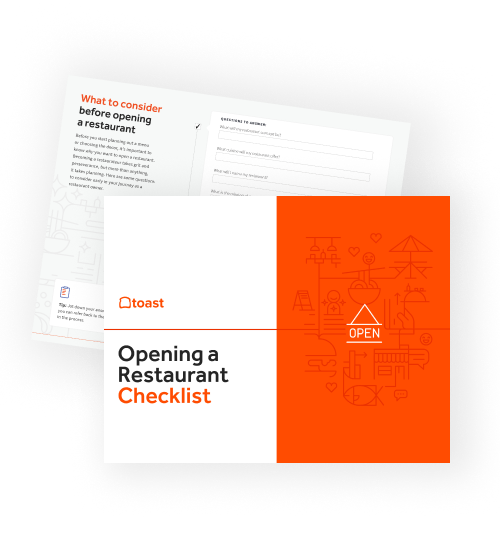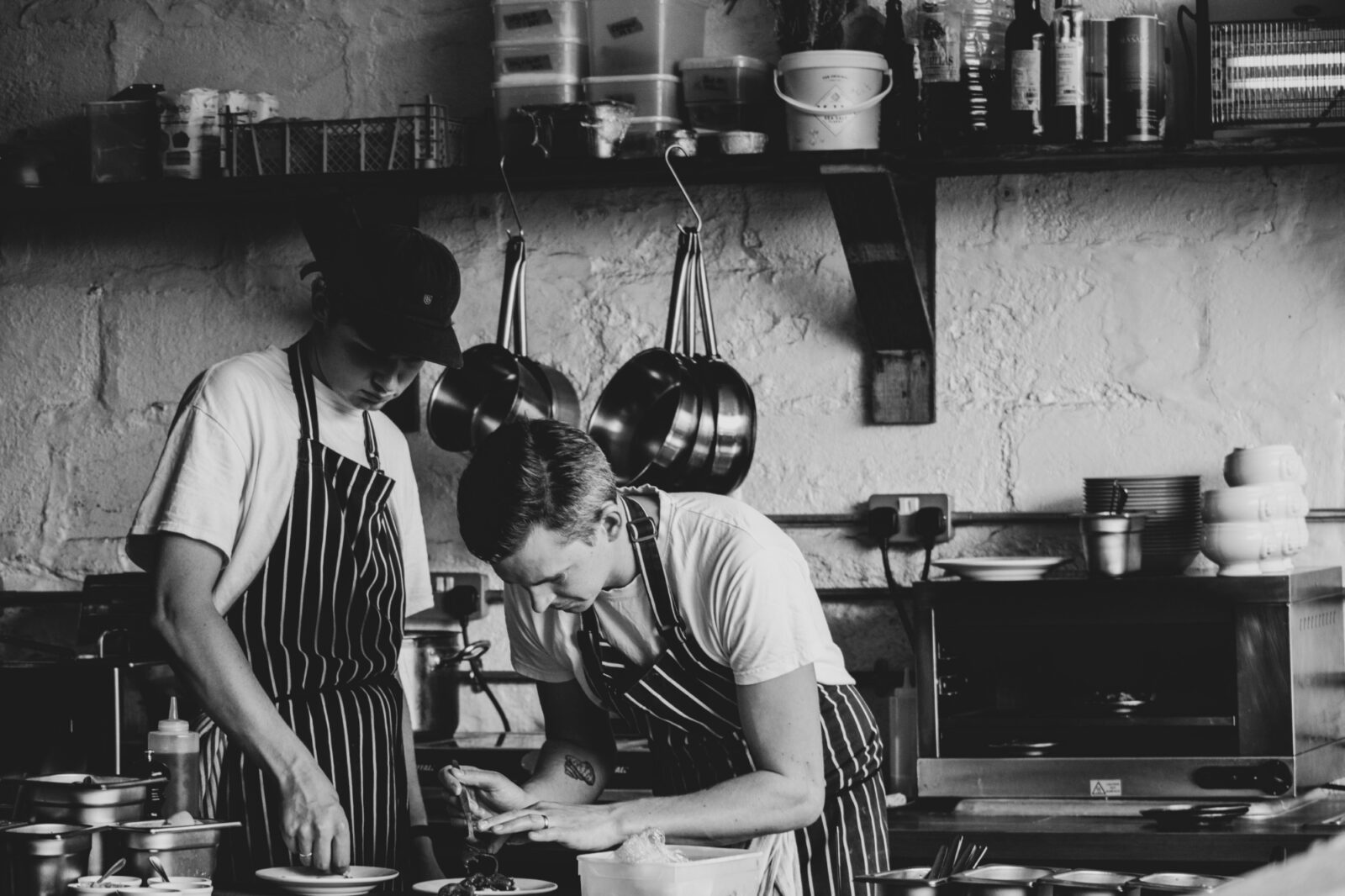
What is a Commercial Kitchen: Commercial Kitchen Definition and Meaning
Everything you need to know about the restaurant industry’s outsourcing innovation.

Nick PerryAuthor


Opening a Restaurant Checklist
So many things go into opening a restaurant. Use this free PDF checklist to set your new restaurant up for success.
The food and service industries have evolved to be more on-demand than ever in recent years, which has required kitchens to evolve, too. One of the key developments to support this demand is the commercial kitchen.
Commercial kitchens are built to support restaurants, delivery services, and catering services all over the world. While any kitchen made to produce large volumes of food — like in a hotel or restaurant — is technically a commercial kitchen, the term has taken on a more nuanced meaning in recent years.
In this article, you will learn the key features of the modern commercial kitchen, understand how they work, and what you need to know to set up your commercial kitchen.
Recipe Card Template
Train your team with this recipe card template, a customizable Excel sheet that outlines recipe requirements for chefs and back of house staff.

What is a Commercial Kitchen?
A commercial kitchen is one designed for food-focused businesses and organizations that have a large volume of food to produce. They are made to facilitate the quick production and sale of food to customers who aren’t necessarily in the same building.
Commercial kitchens tend to be very large and, if not in a dedicated restaurant space, may support several different operations at the same time. They are designed to make meal preparation and delivery easier, making them especially popular with delivery services, bakeries, catering companies, and other to-order foodstuffs like Goldbelly.
As Nina Compton says, "When you run a kitchen, no matter how crazy and chaotic it gets, you have to be the calm one.” Commercial kitchens help produce a level of calm by giving organizations a central place to produce food to distribute to end consumers.
Key Features of a Commercial Kitchen
Beyond its sheer size, there are multiple key features of a commercial kitchen.
Equipment and Appliances
Commercial kitchens are loaded with specialized appliances and commercial-grade equipment that can support the production of mass quantities of food. Not only that - this equipment is built for heavy-duty, long-term use. We’re not talking about your Grandma’s KitchenAid.
A typical commercial kitchen will have industrial stoves, ovens, grills, fryers, refrigerators, and dishwashers that are all built to withstand heavy, frequent use. In commercial kitchens geared more towards baking, you will likely see very large countertops, enormous mixing machines, and extensive storage for supplies.
Size and Layout
Many restaurants can operate with small kitchen spaces and, technically, these tight spaces are still commercial kitchens. However, as the term has evolved to include mass-production kitchens, the term “commercial kitchen” is more commonly used to refer to large, very carefully planned kitchens.
Just like a lot of thought goes into a restaurant floor plan, commercial kitchen layouts are meticulously designed to optimize workflow and productivity, regardless of who is using the kitchen.
Workstations are strategically placed to allow chefs and kitchen staff the space to move and navigate the kitchen safely as they prepare large meals. Building a commercial kitchen specifically takes into account the different stages of food preparation, from chopping and seasoning ingredients to cooking and plating. The design itself is created to support heavy-duty food output.
Compliance with Health and Safety Regulations
One of the most important (and challenging) tasks of any restaurant is to stay compliant with health and safety regulations. In a fast-paced, demanding environment, it’s easy to make little mistakes or overlook violations. One of the primary benefits of commercial kitchens is that they strictly adhere to health and safety regulations.
Commercial kitchen operators uphold rigorous cleaning and sanitation practices to ensure the kitchen is always hygienic and safe. In their designs, commercial kitchens have proper ventilation systems, fire suppression equipment properly placed, and a layout that is safe and up to code.
Just like any restaurant kitchen, commercial kitchens are subject to regular inspections to remain compliant with local health department regulations, but they also tend to be more proactive about compliance and food safety.
Restaurant Cleaning Checklist
Download the Restaurant Cleaning Checklist, created in partnership with RestaurantSupply.com, to keep track of the cleaning tasks that need to be completed in your restaurant.

Differences Between Commercial and Domestic Kitchens
While commercial and domestic kitchens have the same basic purpose — to produce food — they are considerably different in practice. Here are some of the key differences:
Scale of Operations
There are very large domestic kitchens and there are very small commercial kitchens. A very small commercial kitchen is built to handle far more volume than even a large domestic kitchen. Yes, you may cook for your whole family on Sundays, but commercial kitchens are built to cook for dozens or even hundreds of customers every single day.
Beyond the heavier-duty restaurant equipment needed to run a commercial kitchen, it’s loaded with significantly more cooking supplies and utensils, features meticulous organizational qualities, and has more appliances to meet all of the various menu needs. And, again, commercial kitchens meet these needs at scale.
Design and Functionality
While domestic kitchens may be laid out for easy access to cabinetry, a more social atmosphere, or simply as an aesthetic piece for a home, commercial kitchens are designed for function over everything.
Commercial kitchens feature careful designs that optimize kitchen workflows, from kitchen prep stations to cooking, baking, and grilling stations, to dishwashing stations, to a line for waitstaff to pick up orders. Even the most thoughtfully designed domestic kitchens are not as ruthlessly designed to cook food as fast as possible.
Regulations and Requirements
While domestic kitchens are subject to regulations and requirements per local building codes, commercial kitchens must also meet specific food safety and public health regulations. A commercial kitchen is subject to regulations and licensing requirements related to kitchen design, equipment standards, waste disposal, and employee training. Not only do they have to be up to code to open, but they are continually assessed to ensure they are up to standards.
The health inspector doesn’t visit domestic kitchens.
Common Uses of Commercial Kitchens
As the name suggests, commercial kitchens are used for commercial food operations. These are some of the most common applications.
Restaurants and Cafes
Most restaurants and cafes rely on commercial kitchens to produce food for customers. There is a little nuance here, too. Cafes or diners that have just a panini press or a grill behind a bar may not really look like a commercial kitchen, yet technically they would still qualify. After all, this type of commercial kitchen is subject to the same regulations and licensing requirements and is optimized in a way that makes sense for cooks to turn over food quickly. These are rare instances in which commercial kitchens more closely resemble domestic kitchens.
Catering Companies
Catering companies typically support large events, requiring a significant amount and variety of food. As such, they will often use commercial kitchens to prepare food for events, parties, or corporate functions and bring it already prepared to set up at the event. Commercial kitchens provide the infrastructure and equipment to prepare large amounts of food. Then, caterers just have to set up the presentation and service.
When hosting at a private residence, caterers often use domestic kitchens to prepare food for the event, but this doesn’t reclassify a domestic kitchen as a commercial one.
Restaurant Banquet Event Order (BEO) Template
This free BEO template can help your restaurant optimize incoming catering requests and streamline documentation.

Delivery Services
The rapid growth of food delivery platforms has seen a corresponding rise in the number of commercial kitchens specifically used to support delivery services. Often referred to as ghost kitchens, these commercial kitchens have the sole purpose of supporting delivery services by exclusively preparing takeout and delivery orders.
Ghost kitchens are more commonly utilized by large chains that have the order volume to justify paying for the space and staff to outsource takeout and delivery operations. Essentially, these restaurants use ghost kitchens as a secondary, offsite kitchen to streamline operations and cater to an increased demand for delivery food.
Commercial kitchens might be your solution
Commercial kitchens come in many shapes and sizes with key features that distinguish them from domestic kitchens. These kitchens are made to produce food at high volumes and are subject to more stringent regulations and licensing requirements. Moreover, in recent years, the rise of ghost kitchens has blurred the definition, as many industry people now use the term commercial kitchen to refer to offsite, support kitchens as opposed to onsite restaurant kitchens.
Is this article helpful?
DISCLAIMER: This information is provided for general informational purposes only, and publication does not constitute an endorsement. Toast does not warrant the accuracy or completeness of any information, text, graphics, links, or other items contained within this content. Toast does not guarantee you will achieve any specific results if you follow any advice herein. It may be advisable for you to consult with a professional such as a lawyer, accountant, or business advisor for advice specific to your situation.
Read More
Subscribe to On the Line
Sign up to get industry intel, advice, tools, and honest takes from real people tackling their restaurants’ greatest challenges.

